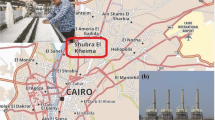Abstract
Aerosol sampling in Kazakhstan was performed at a remote astronomical observatory in the Tien Shan mountain region. The background character of the site was considered by comparing the elemental concentrations, obtained by Energy Dispersive X-Ray Fluorescence (EDXRF), with those reported for other remote stations. On the basis of the variability of the elemental concentrations and the source of origin, the elements could be classified into two main groups. These findings, complemented with enrichment factor calculations revealed the first group of elements to be originating mainly from local sources, and the second group to be related to long-range transport of anthropogenic aerosol. Automated individual particle analysis by electron probe X-ray microanalysis (EPXMA) and subsequent cluster analysis resulted in the identification of 12 distinct aerosol particle types. Relative particle type abundances were converted to absolute abundances by estimating the particle number concentrations for the detected particles, exploring the seasonal particle variation. Based on the absolute abundances, a strong seasonal pattern was found for Si-Al-Fe-, Si-, Ca-S-Si-, Ca-Si-, Fe-Si- and Ti-Si-rich particles. These particle types can mainly be attributed to the local soil source. For most of the remaining particle types, a completely different seasonal trend was found, which can be related to anthropogenic emissions. Their abundance in winter can be related to long-range transport of anthropogenic aerosols. As a result, these data can be representative for the Tien Shan site and may be useful to climate modellers and environmentalists.
Similar content being viewed by others
References
Bondarenko, I., Treiger, B., Van Grieken, R., and Van Espen, P., 1996: IDAS: A Windows based software package for cluster analysis, Spectrochim. Acta B 5 1, 441–456
Ducastel, G., 1994: Het atmosferisch Aërosol in Zuidelijk Noorwegen en het Arctisch Gebied: Chemis-che Samenstelling,Deeltjesgrootte, Bronnen en Brongebieden, Ph.D. Thesis, University of Ghent, Belgium (in Dutch).
Duce, R., Hoffman, G., Ray, B., Fletcher, I., Wallace, G., Fasching, J., Piotrowicz, S., Walsh, P., Hoffman, E., Miller, J., and Heffter, J., 1976: Trace metals in the marine atmosphere: Sources and fluxes, in H. Windom and R. Duce (eds.), Marine Pollution Transfe r,Lexington Books, Lexington, Massachusetts.
Hacisalihoglu, G., Eliyakut, F., Olmez, I., Balkas, T. I., and Tuncel, G., 1992: Chemical composition of particles in the Black Sea atmosphere, Atmos. Enviro n. 2 6A, 3207–3218.
Isakson, J., Oblad, M., Lindgren, E. S., Fridell, M. D., Pacyna, J. M., and Makinen, M., 1997: Perturbation of background aerosol at rural sites in the Nordic countries, Atmos. Environ. 3 1: 3077–3086.
Katrinak, K. A., Anderson, J. R., and Buseck, P. R., 1995: Individual particle types in the aerosol of Phoenix, Environ. Sci. Technol. 2 9, 321–329.
Koutsenogii, K. P., Kovalskaya, G. A., Smirnova, A. I., Makarov, V. I., and Kirov, E. I., 2000: Multielemental composition of atmospheric aerosol in the South of West Siberia, Nucl. Instrum. Meth. A. 44 8, 438–441.
Kriews, M., 1992: Charakterisierung mariner Aerosole in der Deutschen Bucht sowie Proze studien zum Verhalten von Spurenmetallen beim Ubergang Atmosphäre/Meerwasser. Dissertation zur Erlangung des Doktorgrades des Fachbereichs Chemie der Universität Hamburg, Germany, (in German).
Maenhaut, W., Cornille, P., Pacyna, J. M., and Vitols, V., 1989: Trace element composition and origin of the atmospheric aerosol in the Norwegian Arctic, Atmos. Environ. 2 3, 2551–2569.
Mason, B., 1966: Principles of Geochemistr y,Wiley, New York, pp. 329.
Molnar, A., Meszaros, E., Bozo, L., Borbely-Kiss, I., Koltay, E., and Szabo, G., 1993: Elemental com-position of atmospheric aerosol particles under different conditions in Hungary. Atmos. Environ. 27 A, 2457–2461.
Van Espen P., 1984: A program for the processing of analytical data (DPP), Anal. Chim. Acta. 16 5, 31–49.
Van Espen, P., and Janssens, K., 1993: Spectrum evaluation, in R. Van Grieken and A. Markowicz (eds.), Handbook of X-ray Spectrometry, Methods and Techniques,Marcel Dekker, New York, pp. 181–293.
Van Malderen, H., Van Grieken, R., Bufetov, N. V., and Koutzenogii, K. P., 1996: Chemical charac-terization of individual aerosol particles above Lake Baikal, Siberia, Environ. Sci. Technol. 3 0, 312–321.
Vekemans, B., Janssens, K., Vincze, L., Adams, F., and Van Espen, P., 1994: Analysis of X-ray spectra by iterative least squares (AXIL): New developments, X-Ray Spectro m. 2 3, 278–285.
Author information
Authors and Affiliations
Rights and permissions
About this article
Cite this article
Hoornaert, S., Godoi, R.H.M. & Van Grieken, R. Elemental and Single Particle Aerosol Characterisation at a Background Station in Kazakhstan. Journal of Atmospheric Chemistry 48, 301–315 (2004). https://doi.org/10.1023/B:JOCH.0000044432.74476.b0
Issue Date:
DOI: https://doi.org/10.1023/B:JOCH.0000044432.74476.b0




